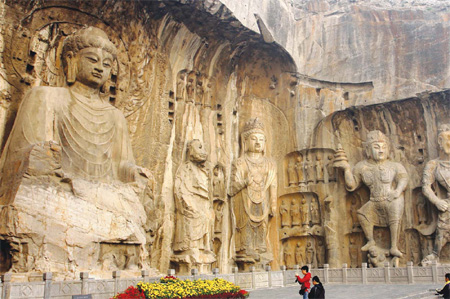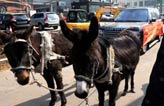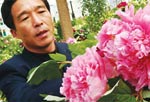A cut above
Updated: 2011-03-25 10:14
By Liu Lu (China Daily European Weekly)
The ancient city of Luoyang is home to a treasure trove of cultural wonders
There is one city in China where artistic, religious and scientific cultures all once thrived like never before. Taoism originated there and the first Buddhist temple was set up in the confines of the city. This special spot is also the hometown of China's most famous inventions including papermaking, printing and the compass. It also was the breeding ground of the nation's most brilliant poets and painters.
 |
|
The Longmen Grottoes are well known for their large numbers of |
Today, Luoyang still inspires the legions of tourists who visit every year.
Located in the middle reaches of the Yellow River in Central China's Henan province and encircled by mountains and plains, Luoyang occupies an important strategic location.
As one of China's seven ancient capitals, Luoyang was a seat of power for 13 dynasties and is a city with splendid historical and cultural background.
Its long history endows it with rich culture, which is seen in grand palaces, temples and caves.
The city is also well known as the "City of Peony". In spring, many tourists travel to Luoyang to appreciate the beautiful peony flowers.
With 21 State-level heritage sites, Luoyang is now an energetic and charming tourism hub that welcomes guests from all over the world to explore its glorious past. Here are five must-see locations.
1. Longmen Grottoes
In 2000, UNESCO included the Longmen Grottoes in its list of World Heritage sites.
As one of the three most famous grottoes in China, they contain a treasure chest of ancient Buddhist cave art. The carvings in the grottoes are well known for their large numbers, their massive scale, the variety of subjects and the delicate and detailed art work.
Its construction began in AD 493 during the reign of Emperor Xiaowen of the Northern Wei Dynasty (AD 386-534), when the rulers moved their capital to Luoyang.
Construction continued through six successive dynasties spanning more than 400 years.
There are altogether 1,352 caves, 785 niches, and more than 97,000 statues of the Buddha. One third of these cave sculptures were constructed during the Northern Wei Dynasty and two thirds in the Tang Dynasty (AD 618-907), in which this style of stone carving reached its pinnacle of the development. Works created during the Tang were very distinct compared with grottoes created earlier.
The statue of Bodhisattva Vairocana is the biggest Buddhist statue in Longmen Grottoes and is a must-see on this leg of your Louyang adventure.
E-paper

Rise and shine
The Chinese solar energy industry is heating up following recent setbacks in the nuclear sector
Preview of the coming issue
Bombs aim for regime change
CSI, with a twist
Specials

Donkey-powered Land Rover
Two donkeys pull a broken-down Land Rover in Shenyang, Liaoning province.

China Fashion Week
Models present creations for the Hosa Swimwear Trend Press Conference 2011.

Peony express
Growers of china's unofficial national flower are reaching out to europe for help
